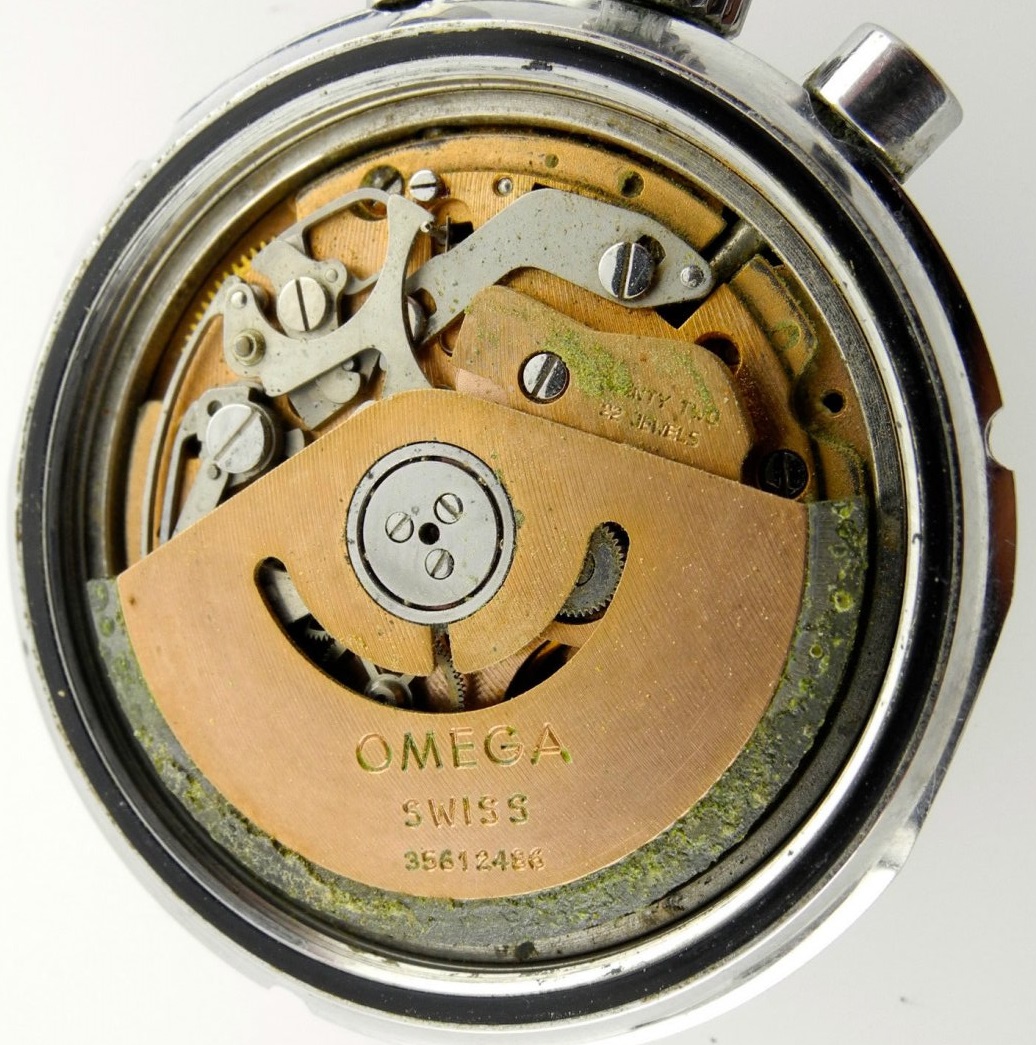Calibres 1040 and 1041 occupy a very interesting place in Omega’s history. They are easily distinguished from all other movements Omega used or produced in functionality, dial layout, and aesthetics. This uniqueness translates to both the dials used and the cases they inhabit.
The calibres have important historical significance: 1040 was the first self-winding chronograph movement used by Omega and 1041 was chosen for and only used in a commemorative edition celebrating the company’s 125th anniversary.
Knowing what to look for under the hood when considering one of these watches is possibly even more important than the exterior features, since it is this special movement that lends itself to those quirky asymmetrical dials after all. Following is my attempt to make sense of these movements from a collector’s perspective.
I’m not a watchmaker nor am I very technically inclined so this will be more of a collection of information I’ve learned from various sources rather than a detailed technical analysis of the movement. I’ll point to the various sources I lean on along the way, but hopefully it will be helpful to have all of the data in one place.
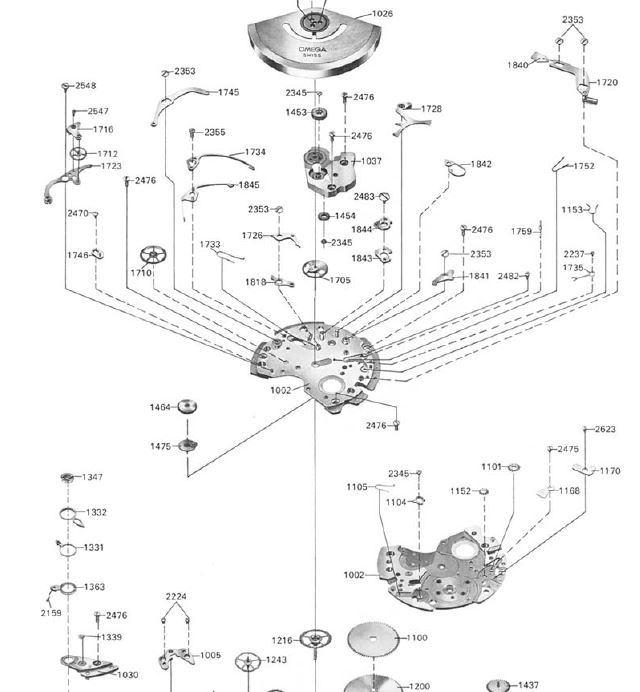
Early Automatic Chronographs and Omega 1040 Overview
The earliest automatic chronographs available to consumers were sold in 1969. Seiko, Zenith, and the “Chronomatic” group consisting of Heuer, Hamilton, Breitling, and Buren were the winners of this race. For more information on the race to be first, check out this great article by Jeff Stein on On The Dash. You might notice that Lemania, one of the leading manufacturers of manual wind chronograph movements at the time, isn’t even mentioned in the article. Was Lemania close to debuting an automatic chronograph around the same time as the competition, or did they have to scramble to get theirs to market shortly after? My guess is that Lemania was deliberate and did not release these calibres in a rush, if only because the overall high quality of the movements.
I have not come across a substantial early history of either the Omega 1040 or Lemania 1340/1 and most of what I know comes from a couple of paragraphs in Marco Richon’s A Journey Through Time. Omega frequently cites the cal. 1040 as dating to 1970, but it appears that date comes from the date of a patent for a rotor mounted on ball bearings which is dated December 28, 1970, which is nearly two full years after the El Primero was announced. I suppose this is just another mystery that adds to the allure of these calibres. We may never know more about their development.
Some of the basic facts about the movement from A Journey Through Time:
- Produced by Lemania exclusively for Omega
- Designed by Raoul-Henri Erard in 1970
- Head of project was Albert Piguet (who had develeoped a prototype automatic chronograph movement in 1946, which was dismissed by Paul-Emile Brandt as “superfluous”)
- The rotor on ball bearings system, patented December 28, 1970, was deigned by Marius Meylan-Piguet
- Omega cites 82,200 and 2,000 as the production totals for calibre 1040 and 1041, respectively (one of those numbers is way off in my opinion)
- Cal. 1041 is the world’s first chronometer-certified automatic chronograph
Useful Reading
- A fantastic overview of the 1040 family on Omega Forums
- An essay on the 1040, 1041, and Lemania 5100-based 1045
Omega 1040 and 1041 vs. Lemania 1340 and 1341
Calibre 1040 is an Omega-exclusive movement made by Lemania based on the Lemania 1340. Before diving into the Omega versions, let’s take some time to understand these two movements.
Common Features
All four of the above-mentioned calibres contain the following features
- Two button, cam-operated chronograph
- Central chronograph minutes and seconds hands
- Running seconds at 9:00
- Hour counter at 6:00
- 28,800 BPH
- 44 hour power reserve
- Bi-directional winding rotor
Beyond these features, the four calibres begin to diverge. A table tells the story best:
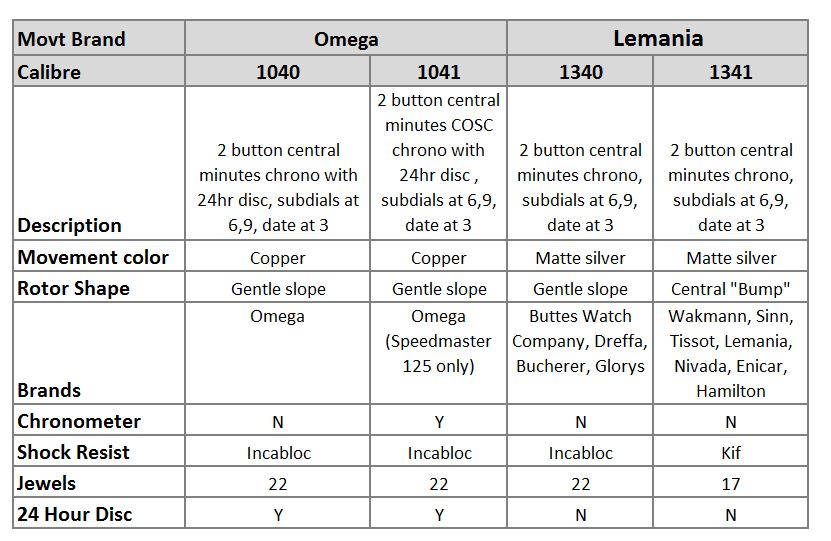
Note on Jewel Count:
The counts in the table above are standard, but there was also a 17 jewel version of the Omega 1041 (see below), and there could easily have been 17 jewel versions of the Omega 1040 and Lemania 1340 also. I recently was made aware of the 17 jeweled 1041 and I can’t say how rare these were. I many have seen more but never caught it.
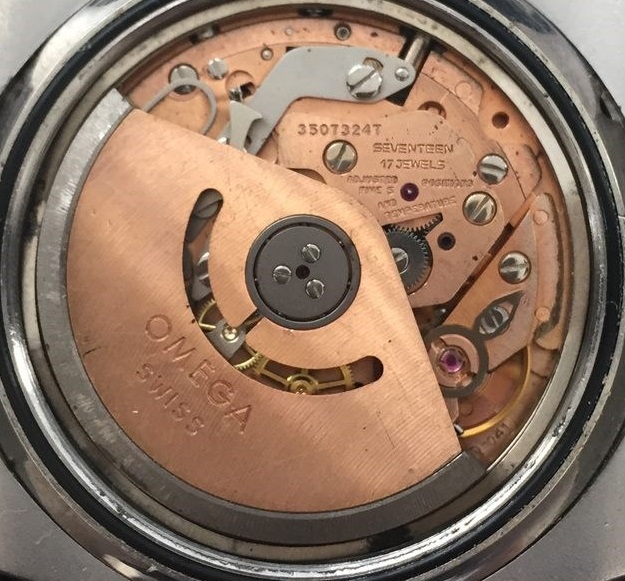
It was not uncommon for Swiss companies to make reduced jewel count versions of their movements to reduce the import duties in key markets such as the US. Generally speaking the duties are calculated by jewel count so 17 is a typical count for the US version of a movement. The Speedmaster 125 the pictured movement was found in New Zealand.
Lemania 1340
This is best considered the base calibre that the rest of the family is derived from. Calibre 1340 is the least common version and was used in lesser-known brands. It is similar to the Omega versions in rotor shape, use of Incabloc shock protection, and a jewel count of 22. The finish has a silver color to it, and it does not have the 24 hour disc, which is an Omega-only feature.

Lemania 1341
This is the common non-Omega calibre. Like the 1340 it is silver in color, but it has a distinct shape to its rotor which is easy to spot at a glance. (Note that Omega cal. 1040 and 1041 service rotors are often the same shape as Lemania 1341 rotors). It has a reduced jewel count of 17 and uses Kif shock protection and a different regulator. The 1341 is found in more common brands than the 1340 (Nivada, Wakmann, Enicar, Hamilton, Tissot) and from a slightly later era than the Omega 1040/1 – late 1970s into the 1980s.
There is a great discussion of the differences in these four movements found in this thread on Omega Forums.

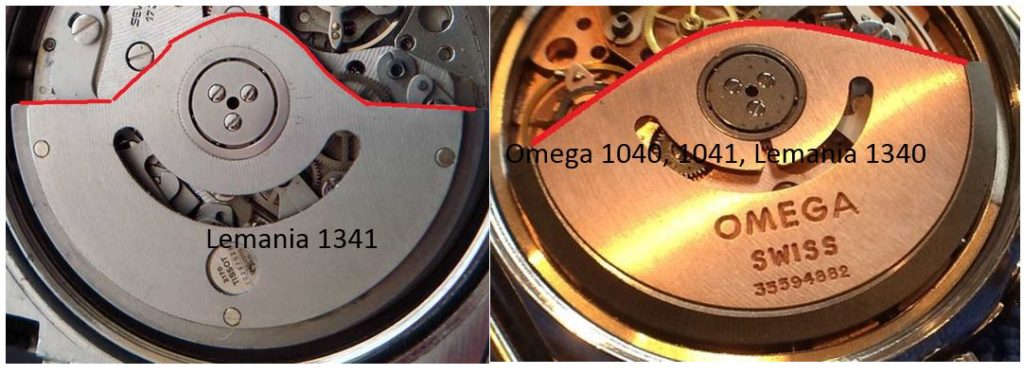
Omega 1040
The 1040 looks like a copper-colored 1340. Like the 1340 has 22 jewels, Incabloc, and a similar rotor, but the Omega obviously gets the 24 hour disc. The distinctive feature of this calibre is the serial number on the rotor.
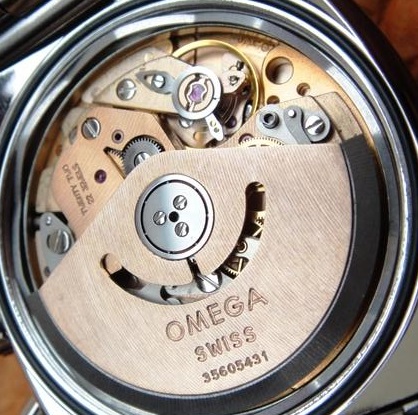
Omega 1041
The only COSC certified chronometer of the family. Very similar to the 1040, but the serial here is stamped on the bridge rather than the rotor. The 1041 is functionally identical to the 1040, and they vary only by three parts: the rotor, the main plate, and the chronograph bridge. These parts only vary by the stamped markings of calibre number, serial number, and text. Otherwise, cal. 1041 is essentially a re-badged 1040 that was sent for and passed COSC testing.
See Chuck Maddox’s article on the Speedmaster 125 for more info. It is where I found the following image on the three parts that differ:
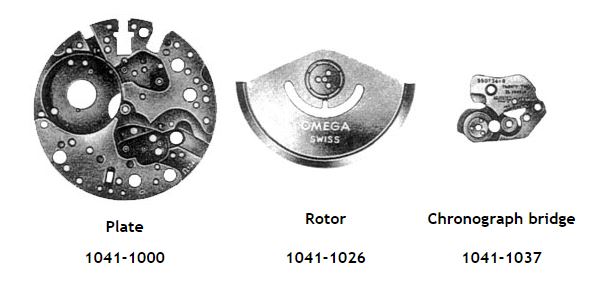
Calibre 1041 is only found in the Speedmaster 125, ref. 378.0801. I have seen the 1041 in other cases that should house the 1040 where the seller is claiming to have a special or rare chronometer, but the 1041 does not belong in any other watch other than the Speedmaster 125.

What collectors should look for – Correctness
Vintage watch collectors seek to avoid frankenwatches, so correctness is a must. Originality is also prized. Correctness and originality are not just limited to the visible, external parts of a watch. Always ask for movement pics when considering purchasing a watch. The good news is that incorrect parts are easy to pick out on calibres 1040 and 1041.
Rotor
I’ll discuss service rotors shortly, but first let’s discuss original rotors. The original rotors share the same gently-sloping shape along the top as Lemania 1340 rotors possess. I’m not aware of any other Omega calibres that used a similar rotor shape and stamped the serial on the rotor. For that reason, it is easy to identify an Omega 1040 rotor as correct.
I personally try to avoid service rotors since they have a different shape and look to them, and in the case of cal. 1040 usually do not include the original serial number. Performance of the watch isn’t affected by a service rotor, but in my opinion service rotors detract from the overall value of the watch and make it harder to pin down the correctness and originality of the rest of the watch.
1040
An original rotor should have the 8-digit serial number stamped in straight writing under “OMEGA” and “SWISS” on the rotor. There should be no screws or weights on the main rotor and the counter weight around the outer edge of the rotor should be clean and black/ dark grey.
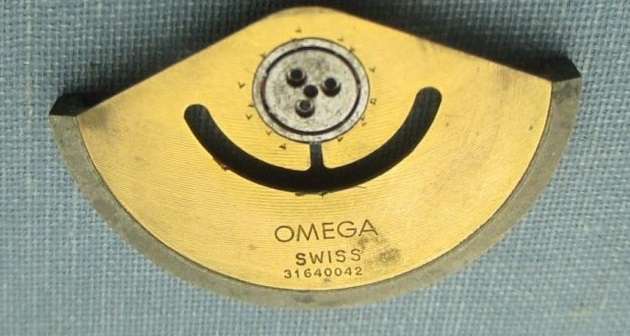
1041
1041 rotors are identical to 1040 rotors except there should not be a serial number.
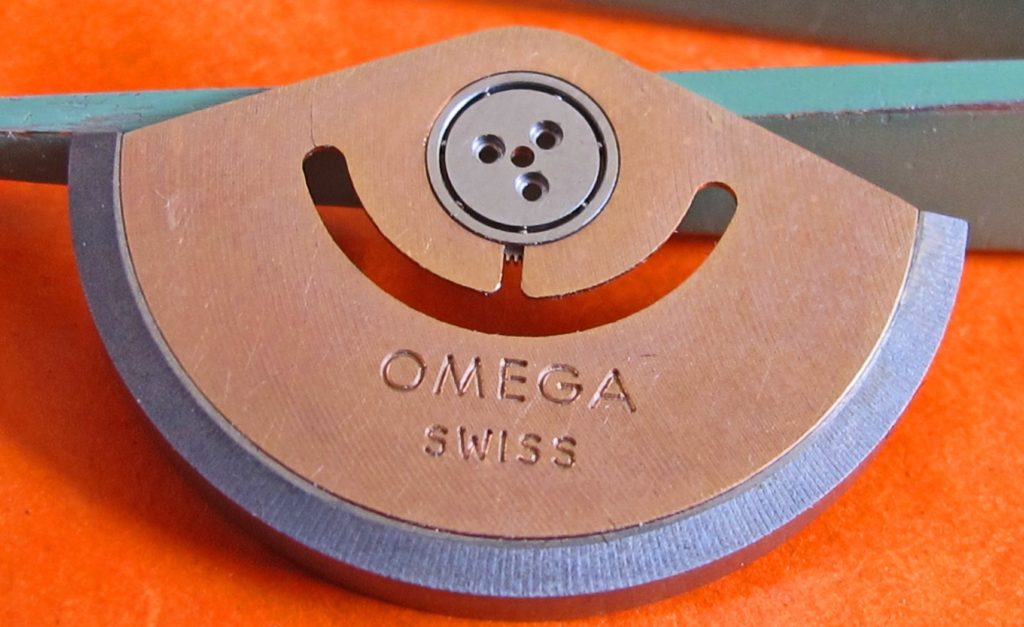
Chronograph Bridge
The bridges are different on cal. 1040 and 1041. The 8 digit serial number is here on cal. 1041.
1040
The text stamped on a 1040 bridge should be:
“TWENTY TWO
22 JEWELS”
Note that I have seen a couple occasions where the serial number on a cal. 1040 is stamped on the bridge in addition to the rotor, and the serials match. In all of these occasions, the serials are very early, in the 31 millions. The theory is that perhaps early on Omega put the serial in both places but quickly went rotor-only.
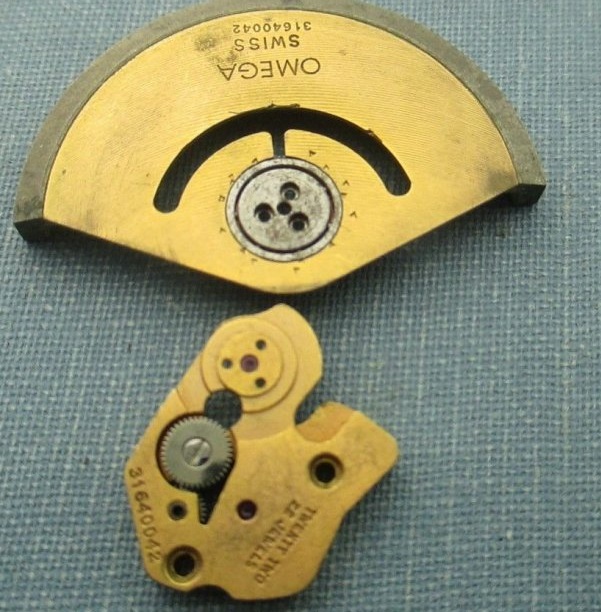
1041
The 1041 bridge has extra text crammed onto it:
“[8 digit serial number]
TWENTY TWO
22 JEWELS
ADJUSTED FIVE 5 POSITIONS
AND TEMPERATURE”
Just a quick glance at the color of the movement, the rotor, and the bridge is usually enough to determine if the movement is correct for the case it is found in.
Incabloc
Incabloc and Kif are probably the two most common shock resistance systems used in mechanical watches, certainly in the 1970s. In recent years, large watch companies have moved toward proprietary, in-house systems. I’m sure both work fine, but I find them particularly useful as an identification tool that is easily spotted, even for people like me that don’t have a watchmaker’s level of understanding a watch movement. As long as the rotor is not in the way, you can identify the antishock system by the shape of the spring that holds the visible capstone. See below:
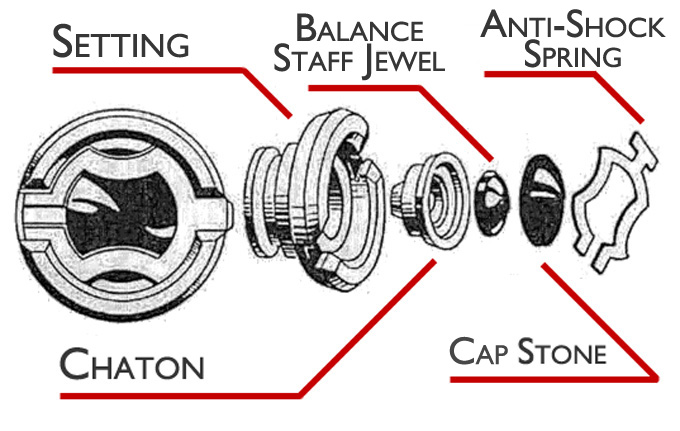
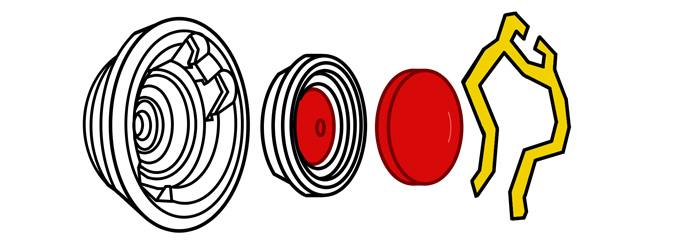
Kif is used in the Lemania 1341, while the other calibres in the family use Incabloc.
Color
Some Lemania 1340 and 1341 parts are compatible with the Omega calibres, so make sure the colors are copper, indicating they are the Omega version of the part.
Service Rotors
Service rotors for Omega calibre 1040 and 1041 tend to tend to be shaped like Lemania 1041 with a rounded “bump” toward the center. They often have additional screws or weights on the rotor itself. The serial number is usually missing and a “service serial” is usually present. The service serial is usually 5 digits and usually is preceded with an R.
Some service rotors have the full, original serial number added to them in large, angled font:
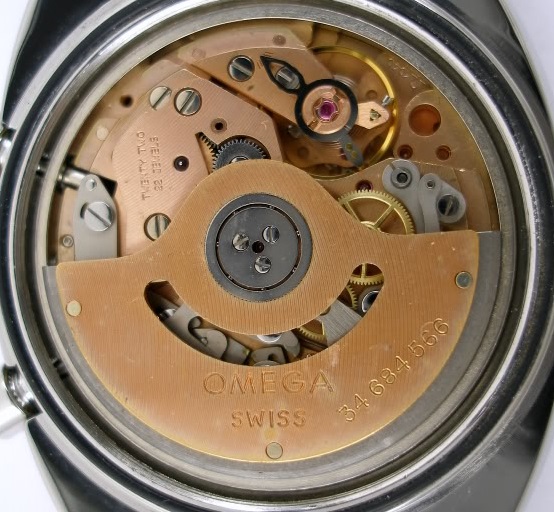
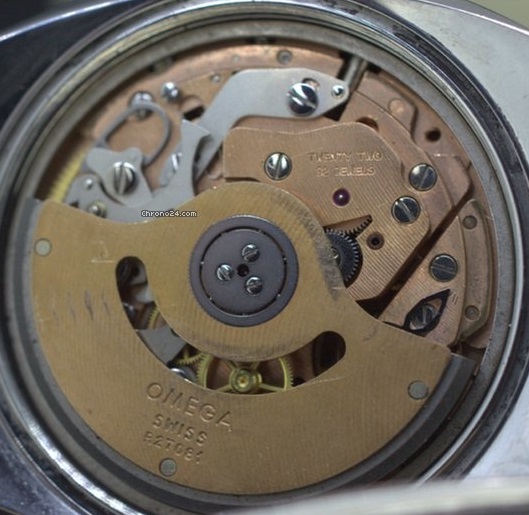
Here is a service rotor with an “R serial”. Photo source: Chrono24, seller unknown
Service Bridges
UPDATE – JULY 2017
I have now also seen a service bridge for a cal. 1041, with the “R serial” stamped where the full SN normally is stamped.
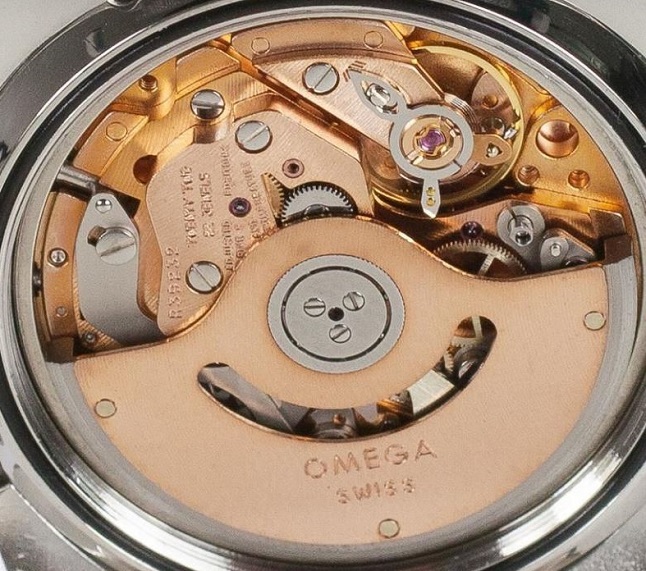
What Collectors Should Look For – Condition
It’s impossible to tell if you are looking at a movement that runs well and has been recently and properly serviced from a photograph. But a photo can give clues that a movement has not been treated well. This thread is written by an actual watchmaker and covers applies to most movements. I’ll go through what I specifically look for when it comes to Omega 1040 and 1041s.
Staining, Rust, Green Fuzz, or Debris
These are the most obvious signs that to me a movement is in immediate need of a service.

Green fuzzy stuff growing on the movement is an obvious red flag. Photo source unknown.
Itemized Service Receipt
So many vintage watches are advertised as recently serviced but rarely is proof offered. Chronographs are expensive to service, and most cal. 1040 watches are relatively inexpensive compared to some other peers that you really have to factor this in. If the watch has a documented recent service, this can add value. If there is no known history or the movement photos show some red flags, you need to factor in an additional $300-$1000. By the way, that’s just a ballpark range – I’ve paid less for a chronograph that was serviced without requiring any replacement parts, and I’ve been quoted over $3,000 by Omega for a job that required a new case and dial in addition to their standard (too high) service fee for a cal. 1040. Don’t worry, I politely declined that one.
Color
Again, Omega 1040 and 1041 calibres are copper colored. The finishing of the movement parts (plates, bridges, and rotor) should match in color and should be uniformly copper. Poorly aged examples are losing that finish and degradation can be seen along edges. Sometimes the entire movement can appear more yellow than copper. See the photos of the rotor and bridge with matching serials for an example. I think this might be the result of a chemical cleaning attempt. These movements might still function correctly, but I recommend avoiding them.
Screws
If the screw heads look gnarled, that could be an indicator of an amateur repair job and potentially more damaged parts that can’t be seen immediately.
Missing Screws, Jewels, Text Stampings, or Other Parts
Use google image search to pull up photos of the movement for comparison. Look for anything missing or different. Even if you don’t know exactly what you’re looking at, any differences should raise a red flag.
Wear marks
Automatic movements that are damaged or poorly serviced often end up showing wear on the rotor contact with the caseback or vice versa. Bridges or plates might also show wear from contact with the rotor.
Should the Serial Number be in a Certain Range?
Maybe. But maybe not. I track all the serial numbers I see on cal. 1040 and 1041 watches, and I have seen certain patterns. The patterns are strong but there are always exceptions. Here are some rules of thumb:
- Serial numbers are usually in the 31-38 million range, though there have been some higher and lower.
- I believe the higher and lower outliers are legitimate, because what other movements could those parts (rotor or bridge) come from, if not cal. 1040 and 1041?
- If you’re considering a watch that has a serial that is in a common batch as seen in my guides for each case, it means it is more likely than not correct and original.
- Conversely if the serial is not in a typical batch, I don’t think it rules it out because there are so many exceptions.
- Extracts can be ordered from Omega to tell you which case your movement was originally housed in.

Calibre 1040 Technical Guide
Below is a PDF of the official technical guide that Swatch provides watchmakers for servicing the cal. 1040. Feel free to download and save or read here on Calibre 1040.
Swatch Omega 1040 tech guide

